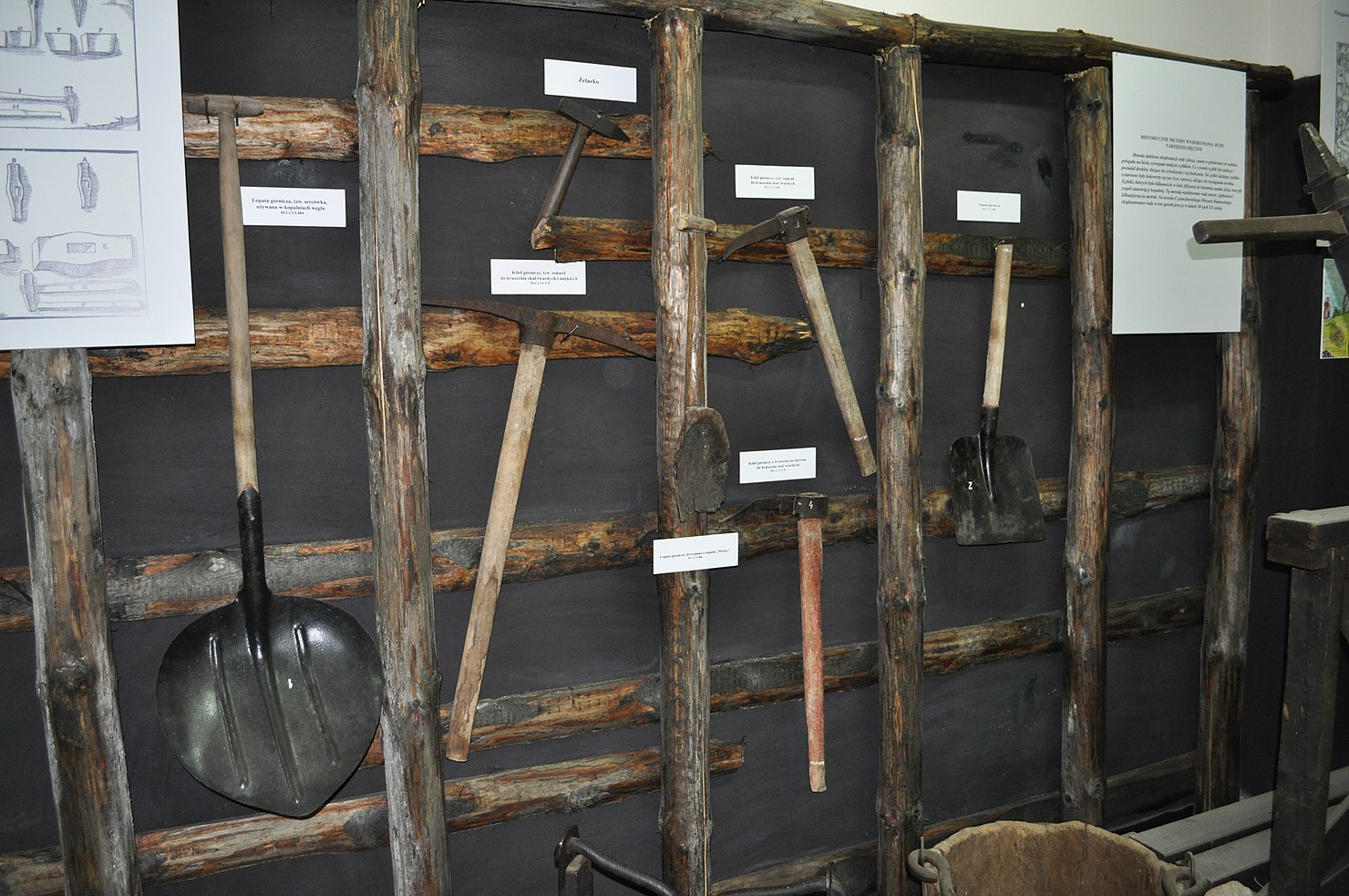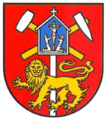Mallets and irons
Mallet and iron is an internationally used symbol for mining . Mallets and Mountain Iron were in the historic mining the most important tools in gezähe the miner .
The tools
beaten ridges with prunes
According to the mining terminology includes hammer and chisel to gezähe of the miner.
- The mallet (also: Schlegel) is a percussion hammer with a square cross-section and a wooden handle - it is a fäustel ( fist hammer) , or a larger pommel (pestle) .
- The recovery iron is an approximately 15 cm long and 2 cm wide wedge or chisel-like tool. The tip is called the village , the face is called the track . The iron has an eye in the middle into which the handle ( helmet ) is inserted. The helmet is not firmly wedged in the eye, but rather loosely inserted and - as can be seen in the symbol - protrudes over the pointed iron. So it can easily be separated from the handle and not only penetrate deeper into a gap, but also a new iron can be attached. This was necessary several times during a work shift because the pointed iron quickly became blunt. Therefore, the miner always took several irons with him to work, which were sharpened again after the shift in the mining forge . The iron belt, which used to be a leather belt, was used for transport, but later, around the beginning of the 17th century, was designed as two flat iron with a carrying yoke. The term iron belt remained. The traces of processing that develop in solid rock are called prunen (also: wells or wells).
For the work in the mining area, other tools such as B. Wedge Hicks , used to knock softer ore or quartz loose. In English ( hammer and pick ) is the pick ( pick taken) Reference, precise would be two flat pick meant ( flights iron ) , while the German icon shows two different hammer-like tools, with one (the iron) as the stone ax - precise : the surface with the transverse blade in the form of the Dexel - the stonemason's can be seen. Other versions of the illustration show a splitting or driving iron , a setting hammer , a tool with a track and a fin - the track is hit with a hammer to drive the cutting edge into the stone. Which shape is used depends on the local mountain range.
Mallets and irons were previously used in mining. For centuries, this manual work was the only permanent technique for driving tunnels , routes and shafts through the solid rock. Only in the 17th century the displaced shooting with black powder that hand work.
- Various irons in coats of arms
Berggießhübel , Erzgebirge /
Elbe Sandstone Mountains: Magnetic iron ore in compact rocksSchladming , Niedere Tauern: non-ferrous metal ores in fissile slate / limestone
Kupferberg , Frankenwald and Fichtelgebirge: copper in slate (pestle and copper hammer heavily embossed)
Barsinghausen , Deister: sandstones as stone
Historic hard coal mining in Gelsenkirchen and other cities in the Ruhr area
Kaub slate mining in particular the Wilhelm-Erbstollen mine
Historic silver ore mining in Clausthal-Zellerfeld in the Harz Mountains, Lower Saxony
Forestry and mining in Sieber (Herzberg am Harz) , Göttingen district
History, mining and nature stairs (Harz) in Saxony-Anhalt
The town of Oberharz am Brocken in the Harz district was only founded in 2010
Community coat of arms of Zorge (Walkenried) in the district of Göttingen
Bergstadt Oberwiesenthal in the Erzgebirgskreis (Saxony)
The symbol
Since the first half of the 16th century it has been used as a miner's coat of arms, in which the two tools are arranged in the shape of a St. Andrew's cross, exactly as the miner would take them off after work: the iron held in the left hand is with the handle wood to the left and the pointed iron to the right, and the mallet with the right hand, with which the iron is hit on the rock to be broken, points with the handle to the right and the head to the left.
In this arrangement, the tools are within easy reach and the mallet handle is at the right hand of the right-hander. Crossing the bars makes the pair of tools easier to find by touching them - even in the dark; on coats of arms is shown inconsistently which of the two is on top.
In Germany the design is specified in DIN 21800: 1989-06 in the form of dimension tables.
In Unicode there is the character ⚒ U + 2692 HAMMER AND PICK ( Unicode block Various symbols ). However, this internationally valid symbol does not correspond to the form prescribed by DIN.
use
Flagpole at the main building of the Bergakademie Freiberg (historical photo)
House decorations in Essen , Schinkelstrasse in the Moltkeviertel
Detail of the former administration building of Bayerische Braunkohlen Industrie AG in Wackersdorf (Upper Palatinate)
Weather vane of the Herrmannschacht briquette factory in Zeitz
As a symbol
Today the sign can be found in the following meanings:
- It can stand for work in general and thus indicate "in operation".
- In some countries it symbolizes the validity “on working days ” on traffic signs .
- In course books and other timetables, it means that a means of transport only runs on working days. In Germany, after the introduction of the five-day working week, this was still understood to mean Monday to Saturday; in other countries, e.g. B. in the Czech Republic, but Monday to Friday.
- On maps are separated by the mining areas , in particular, mines or open pits symbolizes, on the head are standing "abandoned" mines symbolizes.
- It is also used to characterize a person as a member of the mining industry in the broadest sense, such as (with upturned handles) in obituaries .
As a coat of arms
Mallets and irons also show the mining tradition of the region or town on many coats of arms. You are a common figure in heraldry . The color is often black, or heraldic metal is gold and silver.
Hövels according to DIN 21 800
Abertamy : In silver and gold
Bodenwöhr : graphically in gold
Telnice : In natural colors
literature
- Eberhard Wächtler : With flails and iron . of miners and mining traditions. Verlag für die Frau, Leipzig 1996, ISBN 3-7304-0454-7 , p. 96 .
- Walter Bischoff et al .: The small mining dictionary . Ed .: Westfälische Berggewerkschaftskasse . Third edition. Glückauf GmbH, Essen 1981, ISBN 3-7739-0248-4 , p. 179 .
- Heinz Machatscheck: Entertaining heraldry . New Life Berlin, Berlin 1981, p. 40 .
Web links
- Mining room. (including a photo of mallets and irons as real tools). In: heimatverein-rheinbreitbach.blogspot.de. Retrieved November 26, 2016 .
- Mallets and irons in the Heraldry Wiki
Individual evidence
- ↑ STICK, m. tool for hitting 1e) miners' hammer . In: Jacob Grimm , Wilhelm Grimm : German Dictionary . Hirzel, Leipzig 1854–1961 ( woerterbuchnetz.de , University of Trier).
- ^ Heinrich Veith: German mountain dictionary with evidence . Wilhelm Gottlieb Korn, Breslau 1871, p. 147 ( digitized version ).
- ^ Emil Treptow : Basics of mining science . including processing and briquetting. sixth, increased and completely revised edition. 1st volume. Julius Springer, Vienna 1925, III. The stone work, 4. The work with mallets and iron, p. 143-144 .
- ↑ DIN 21800 characters: mallets and irons. Retrieved May 20, 2017 .
- ↑ General remarks . In: Course book of the Deutsche Reichsbahn. Summer timetable 1961 , p. 2.
- ↑ General remarks . In: Course book of the Deutsche Reichsbahn. Winter timetable 1981/1982 , p. 2.
- ↑ Jízdní řád . České dráhy, 1999/2000.
- ↑ Explanation of symbols (excerpt) . In: 2638 - SO Stepenitz (= topographic map 1: 10000) 1997.
- ↑ Obituaries of the geologist Wolfhart Langer : https://trauer.general-anzeiger-bonn.de/trauerbeispiel/wolfhart-langer


























